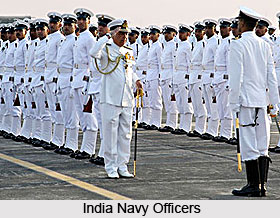 The history of Indian maritime activities predates the birth of western civilisation. In fact the first tidal dock can be traced to the period of Harappan civilisation. There has also been profuse mention of ocean routes and other maritime activities in the Indian mythology. Rig Veda states that Lord Varuna had ample knowledge of the oceans and their routes. According to Indian myths the lesser mortals turned to Lord Varuna asking forgiveness of their sins. It was much later that Lord Indra was came to be known as the King of Gods and Lord Varuna was the King of oceans and rivers. As per legends, the vast sea was looked upon as a treasure house and churned by both the devtas and rakhshasas to obtain nectar. With due respect to Indian beliefs, even today the invocation during the launching ceremonies of warships are addressed to Aditi, the wide of sage Kashyapa and the mother of the rakhshasas.
The history of Indian maritime activities predates the birth of western civilisation. In fact the first tidal dock can be traced to the period of Harappan civilisation. There has also been profuse mention of ocean routes and other maritime activities in the Indian mythology. Rig Veda states that Lord Varuna had ample knowledge of the oceans and their routes. According to Indian myths the lesser mortals turned to Lord Varuna asking forgiveness of their sins. It was much later that Lord Indra was came to be known as the King of Gods and Lord Varuna was the King of oceans and rivers. As per legends, the vast sea was looked upon as a treasure house and churned by both the devtas and rakhshasas to obtain nectar. With due respect to Indian beliefs, even today the invocation during the launching ceremonies of warships are addressed to Aditi, the wide of sage Kashyapa and the mother of the rakhshasas.
The influence of sea continued to grow among the Indian kingdoms with the passage of time. A peep into history states that Chandragupta Maurya had organised a specialised branch in his army in order to look after the ships and the personnel belonging to this department had adequate knowledge about the navigation skills in the sea. Besides the popularity of seas in Indian kingdoms, trade in India through the sea route also grew in leaps and bounds during the early times. India traded with countries like Java, Sumatra and even Rome and Greece. Therefore, in order to continue the flourishing trade in India, knowledge of proper navigation skills was the need of the hour.
Aryabhata I and Varahamihira were astronomers of the early age. They developed ways to locate the position of the ship in the sea. A crude form of magnetic compass was developed by them which located the position in the sea with the help of celestial bodies. It is true that for some time the Indian maritime activities saw a gradual growth but by the thirteenth century the ocean related activities of India declined considerably. Rather it is best said that it completely disappeared with the coming of Portuguese in the country.
Again in the late seventeenth century the maritime activities of India underwent a remarkable resurgence with the coming of the Sidis of Janjira in alliance with the Mongols. It was this period that made Maratha King Chatrapati Shivaji establish a fleet of his own which was controlled by Admirals.
Even after the coming of British rule in India, the ship building industry of the country continued well. At this the British ship builders got agitated and made every effort to cripple the ship building industry of India. As the East India Company came to India they soon realised that India had a great scope for the ship building industry. They also discovered pretty soon that India had a great potential of supporting and fighting a great force.
Hence it can be concluded saying that the growth of Indian Navy has a history of 4000 years between Lothal and the Bombay Dock. Right from the early days India had a great potential for the development of a strong naval force which could be optimally used to fight an enemy.






